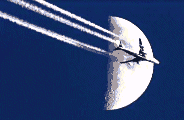- Home
- Airframe and structure
- MCR 4S cabin heat
Contrails ! MCR 4S cabin heat
Cabin heat that works
MCRs are traditionally equiped –when the homebuilder bothers to install one– with a cabin heat system designed by Michel Colomban for the MC 100.
As he points out with humour, "it works very well in summer"...
The IF build team went another way.
Design principles
Original version
The standard setup comprises a small clam shell door opening in the fuselage bottom behind the radiators.
In winter when the air is cold at the radiator exit, or when the cowl flap is closed, efficiency is marginal, and there have been some reports of exhaust fumes ingress.
Furthermore, cutting an aperture into the fuselage bottom did not seem too attractive to the PHIF build team...
A different approach
In the radiator tunnel exit nozzle, the pressure is higher than static pressure, and there is no commmunication with the engine compartment.
So we have a source for pure air under pressure at 70°C (160 F).
In winter when the cowl flap is closed, the air is even hotter due to the reduced cooling flow.
Of course this only works with a properly designed cooling duct. If the cowl outlet pressure is lower than static (resorting to the lip...), then heating the cabin this way is impossible.
Hot air intake
The doorlet
Comparison with ducts in certified aircraft allowed us to determine a suitable door area for adequate heating.
A small door was cut out in the exit nozzle ceiling with a Dremel.
It opens downwards to allow the pressure in the nozzle to help to keep it closed.
The joint generates some airflow perturbation, but let's remember that the speed is still low at the radiator exit, and so is the corresponding drag.
The air leak at the hinge produces a tiny percentage of permanent heating and loss of momentum (!)
Nevertheless in summer it is easy to stick a piece of aluminum tape on the hinge through the cowl flap exit.
Duct and control linkage
Hot air duct
Two layers of glass/epoxy on a foam plug.
The cylindrical portion is for clearance with the engine mount tube. The speed of the hot air is low, and momentum loss unavoidable, so the shape of the duct is not critical.
The control rod has two model clevises.
All screws are installed with nutplates to facilitate future disassembly.
The control lever shaft passes through the firewall in a brass tube brazed to a stainless washer, similar to the electrical cable penetration fittings.
Piano wire rod with soldered model clevis.
Gas seal at the rod passage is ensured by the thermal protection.
Flame test
The hot air duct is covered with thermal protection.
Gas seal with the firewall and radiator tunnel is with high temperature RTV.
The thermal protection and glass layup were tested for several minutes on a gas stove.
Cabin side
Control cable
The control cable attaches to the lever with a ball joint.
The big cable stop acts as a mechanical stop to limit the door opening.
The wire mesh plays a flame trap role. One can add a slide shutter operated together with the doorlet.
The hot air duct nutplates are clearly visible.
Air distribution
At the beginning the outlet was selfishly placed at the feet of the pilot, but now (2013!) a deflector has been added to better distribute the hot air.
Efficiency
Yes it works !
Some of our fellow builders were wondering at seeing us designing a cabin heat in the middle of the 2004 summer. There have even been whispers that "it wouldn't work" ;-)
Nevertheless it is during the build that the aircraft systems must be thought out.
The first flights from +4°C to −14°C confirmed the remarkable efficiency of this little cabin heat system. We never had to use more than one quarter of full opening.
Finally some measurements
We finally managed to take in flight a multimeter with a type K thermocouple - in winter time. The tests were brief, due to the pilot finding the temperatures too warm.
One minute measurements during climb out.
There is a clear bias toward the pilot side. We arer considering moving the deflector to provide a better temperature rigth-left balance.
| Cabin Heat temperatures 17th march 2016 (GTH) | ||||||||||||||||||||||||
|---|---|---|---|---|---|---|---|---|---|---|---|---|---|---|---|---|---|---|---|---|---|---|---|---|
|
||||||||||||||||||||||||
 Contact the author
Contact the author




